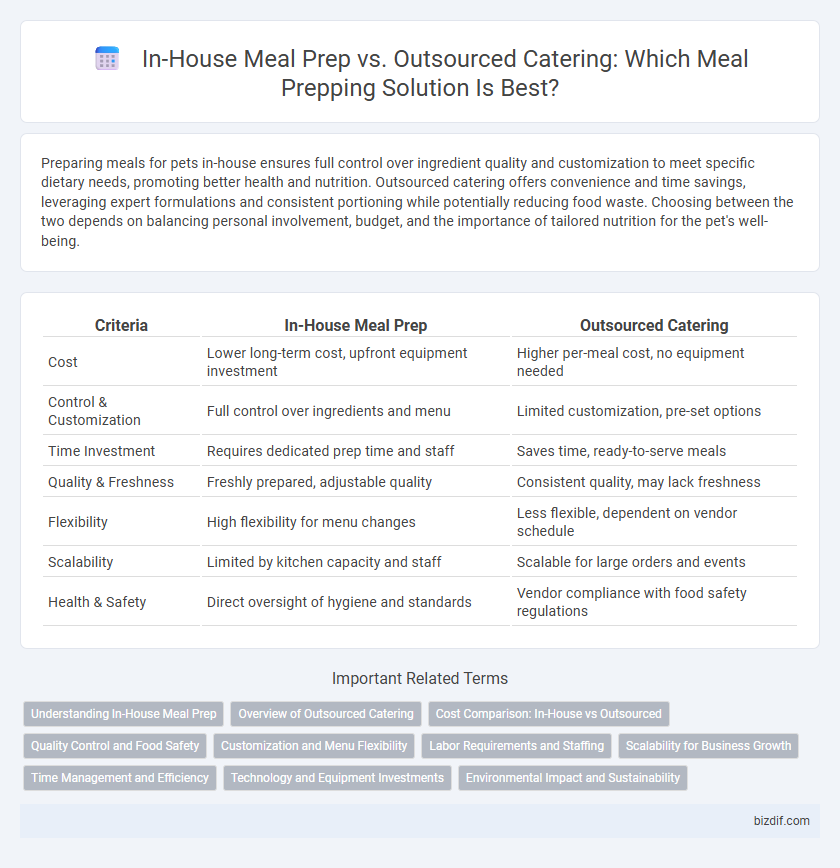Preparing meals for pets in-house ensures full control over ingredient quality and customization to meet specific dietary needs, promoting better health and nutrition. Outsourced catering offers convenience and time savings, leveraging expert formulations and consistent portioning while potentially reducing food waste. Choosing between the two depends on balancing personal involvement, budget, and the importance of tailored nutrition for the pet's well-being.
Table of Comparison
| Criteria | In-House Meal Prep | Outsourced Catering |
|---|---|---|
| Cost | Lower long-term cost, upfront equipment investment | Higher per-meal cost, no equipment needed |
| Control & Customization | Full control over ingredients and menu | Limited customization, pre-set options |
| Time Investment | Requires dedicated prep time and staff | Saves time, ready-to-serve meals |
| Quality & Freshness | Freshly prepared, adjustable quality | Consistent quality, may lack freshness |
| Flexibility | High flexibility for menu changes | Less flexible, dependent on vendor schedule |
| Scalability | Limited by kitchen capacity and staff | Scalable for large orders and events |
| Health & Safety | Direct oversight of hygiene and standards | Vendor compliance with food safety regulations |
Understanding In-House Meal Prep
In-house meal prep offers complete control over ingredient quality, allowing customization tailored to specific dietary needs and flavor preferences. It reduces costs associated with third-party vendors, providing flexibility in portion sizes and scheduling to meet fluctuating demands. Staff involvement in preparation enhances food safety oversight and promotes consistency aligned with company standards.
Overview of Outsourced Catering
Outsourced catering involves hiring external vendors to handle meal preparation, ensuring professional quality and variety without the need for in-house kitchen resources. This option reduces labor costs and minimizes logistical challenges, making it ideal for businesses or individuals seeking convenience and scale. Catering companies typically offer customizable menus tailored to dietary needs, enhancing meal diversity and customer satisfaction.
Cost Comparison: In-House vs Outsourced
In-house meal prep typically incurs higher upfront costs due to equipment, labor, and ingredient purchasing but offers greater control over portion sizes and ingredient quality, potentially reducing waste and ongoing expenses. Outsourced catering presents a fixed cost model with less administrative burden, often benefiting from bulk purchasing and economies of scale that lower per-meal prices. Analyzing cost per serving, including labor and overhead, reveals that in-house preparation becomes more economical at higher volumes, while outsourced services may better suit smaller operations or fluctuating demand.
Quality Control and Food Safety
In-house meal prep allows for direct oversight of ingredient quality and strict adherence to food safety protocols, reducing the risk of contamination. Outsourced catering relies on third-party providers whose standards may vary, potentially impacting consistency and compliance. Effective quality control in meal prepping hinges on transparent processes and regular audits, which are more manageable with in-house operations.
Customization and Menu Flexibility
In-house meal prepping offers superior customization and menu flexibility, allowing for tailored dishes that cater to specific dietary needs and preferences. Outsourced catering often provides limited menu options due to standardized offerings and fixed recipes. Choosing in-house prep enables real-time adjustments and ingredient substitutions, enhancing meal personalization for diverse client requirements.
Labor Requirements and Staffing
In-house meal prepping demands dedicated kitchen staff trained in food safety, preparation, and packaging, often requiring shifts to manage daily production efficiently. Outsourced catering reduces internal labor needs by outsourcing these tasks to specialized providers, allowing businesses to focus their workforce on core operations. Staffing flexibility is enhanced with outsourcing, as it mitigates the risk of overtime and the need for seasonal hiring spikes common in high-volume meal prep scenarios.
Scalability for Business Growth
In-house meal prep offers direct control over ingredient quality and customization but may face scalability challenges due to limited kitchen capacity and labor constraints. Outsourced catering leverages established infrastructure and experienced staff, enabling rapid scaling and consistent delivery across larger volumes. Businesses aiming for growth should assess operational flexibility and cost efficiency to determine the optimal balance between in-house preparation and outsourced solutions.
Time Management and Efficiency
In-house meal prepping demands significant time investment for ingredient sourcing, cooking, and packaging, often requiring dedicated staff and kitchen space which can strain resources. Outsourced catering streamlines operations by leveraging specialized teams and established logistics, enhancing efficiency and allowing businesses to focus on core activities. Evaluating the balance between control over quality and time saved is essential for optimizing meal prep strategies.
Technology and Equipment Investments
In-house meal prepping requires significant investment in advanced kitchen technology and equipment to ensure efficiency, food safety, and quality control. Outsourced catering providers typically leverage specialized machinery and scalable technology platforms, reducing capital expenditure for businesses. Evaluating the cost-benefit of these investments is critical for optimizing operational workflows and maintaining consistent meal production standards.
Environmental Impact and Sustainability
In-house meal prepping reduces carbon emissions through localized sourcing and minimized transportation compared to outsourced catering, which often relies on long supply chains and extensive packaging. Utilizing seasonal, organic ingredients and efficient kitchen operations also enhances sustainability by decreasing food waste and energy consumption. Outsourced catering may offer scalability but typically involves higher environmental costs due to centralized production and broader distribution networks.
In-House Prep vs Outsourced Catering Infographic

 bizdif.com
bizdif.com